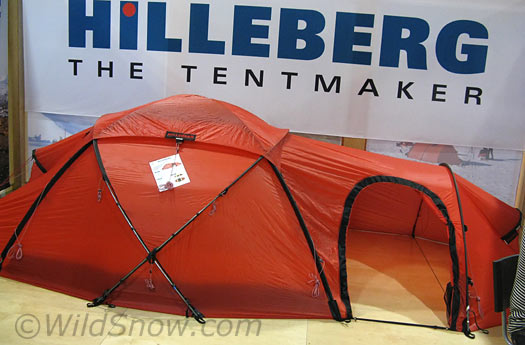Another report from summer Outdoor Retailer trade show:
We chose Hilleberg tents for our Denali backcountry skiing trip last spring, mainly because all Hilleberg designs provide an incredible mix of wind resistance and lack of mass. Most Hillebergs are of the “tunnel” variety, meaning you have to stake out the ends of the structure during setup (a minor inconvenience once you get used to it). We used a couple of Hillberg’s tunnel tents in Alaska. They were superb, though we did experience common tunnel-tent issues such as not being able to hang much weight from the ceiling.
Instead of a tunnel tent during WildSnow Denali, Caleb and Jordan opted for for the Hilleberg Saivo dome tent as they’re both large guys and wanted the roomy interior and two-door configuration the Saivo provides. While adding a bit of weight to our overall expedition load, the Saivo worked well and was nearly as wind resistant as the tunnel tents. I was impressed.
This coming season Hilleberg will be selling the Saitaris, a jumbo version of the Saivo dome with an added large vestibule. Saitaris is designed to fit four sleepers, or three with ultimate comfort. It’s 49 inches high inside, and weighs about 14 pounds depending on your choice of stakes and other accouterments.
Our take? If you want the most room and wind resistance for the least weight, tunnel tents such as Hilleberg’s Keron or Nammatj give you tons of bang for the ounce. If you want more resistance to snow loading and the setup ease of a dome, Saitaris would be an excellent choice as a combined basecamp and travel tent for trips such as the Denali West Buttress.
Bear in mind that both these tents are built with the “double wall” type of construction, meaning they’re basically an inner breathable tent with a 100% waterproof and windproof outer shell, separated by a few inches of air space. In our experience, while double wall tents weigh significantly more than singles, they’re much warmer and develop quite a bit less breath condensation. (You can compensate somewhat for the added weight by carrying a lighter sleeping bag, as the interior of the tent will be warmer at night.) Those are important considerations if you’re winter camping or doing arctic mountaineering, and not so important for activities such as summer backpacking or lower altitude base camps.
So, winter is coming. Are you one of the few and brave backcountry skiers who’ll venture out with a tent instead of heading for a hut? If so, Hilleberg is definitely an option. Check ’em out.
WildSnow.com publisher emeritus and founder Lou (Louis Dawson) has a 50+ years career in climbing, backcountry skiing and ski mountaineering. He was the first person in history to ski down all 54 Colorado 14,000-foot peaks, has authored numerous books about about backcountry skiing, and has skied from the summit of Denali in Alaska, North America’s highest mountain.

